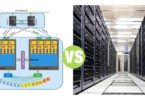Ecommerce vs Retail
Summary: Difference Between E-commerce and Retail is that E-commerce, short for electronic commerce, is a business transaction that occurs over an electronic network such as the Internet. While Retail refers to the sales of good, sold from a single point which includes malls, supermarts, departmental store to the consumer in a small quantity.

E-commerce
E-commerce, short for electronic commerce, is a business transaction that occurs over an electronic network such as the Internet. Anyone with access to a computer or mobile device, an Internet connection, and a means to pay for purchased goods or services can participate in e-commerce.
Three types of e-commerce are business-to-consumer, consumer-to-consumer, and business-to-business. Business-to-consumer (B2C) e-commerce consists of the sale of goods and services to the general public. For example, Apple has a B2C Web site. Instead of visiting a retail store to purchase an iPod, for example, customers can order one directly from Apple’s Web site.
E-retail, short for electronic retail, occurs when businesses use the Web to sell products. A customer (consumer) visits an online business through an electronic storefront, which contains product descriptions, images, and a shopping cart. The shopping cart allows the customer to collect purchases. When ready to complete the sale, the customer enters personal data and the method of payment, which should be through a secure Internet connection.
Consumer-to-consumer (C2C) e-commerce occurs when one consumer sells directly to another, such as in an online auction. With an online auction, users bid on an item being sold by someone else. The highest bidder at the end of the bidding period purchases the item. eBay is one of the more popular online auction Web sites.
As an alternative to entering credit card, bank account, or other financial information online, some shopping and auction Web sites allow consumers to use an online payment service such as PayPal or Google Checkout. To use an online payment service, you create an account that is linked to your credit card or funds at a financial institution. When you make a purchase, you use your online payment service account, which transfers money for you without revealing your financial information.
Most e-commerce, though, actually takes place between businesses, which is called business-to-business (B2B) e-commerce. Many businesses provide goods and services to other businesses, such as online advertising, recruiting, credit, sales, market research, technical support, and training.
Retail
Retail refers to the sales of good, sold from a single point which includes malls, supermarts, departmental store to the consumer in a small quantity. In a layman’s language, retailing is nothing but transaction of goods between the seller and the end user as a single unit (piece) or in small quantities to satisfy the needs of the individual and for his direct consumption.
Let us take an example of buying a Laptop Computer from electronic store.
If you want to purchase a laptop computer, you will go to the nearby store and will purchase one by yourself.
So, you are buyer who purchased a laptop computer from a fixed point (nearby store) in quantity (1).
The Retailer is the store owner who provides you varity of laptop computers and you choose desired one according to your budget.
Supply Chain
| Manufacturers | …………………… | Retailers | ……………. | End User (Consumer) |
| Wholesalers |
Also Read:
Difference Between Ecommerce and Mcommerce
Difference Between Web Publishing and Paper Publishing
Difference Between Ecommerce and Ebusiness







Leave a Comment
You must be logged in to post a comment.